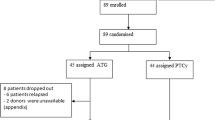Abstract
In a single-center study, we analyzed the outcomes of 66 patients with advanced hematological malignancies receiving two reduced-intensity conditioning regimens for allogeneic transplantation: fludarabine and low-dose TBI (flu/TBI, n=25), or fludarabine, antithymocyte globulin and BU (flu/ATG/BU, n=41). The selection criteria were based on the hypothesis that flu/TBI patients were expected to achieve autologous recovery in the event of non-engraftment. Sixty-three patients (95%) engrafted. Regimen-related mortality at day 100 and 1 year was 6 and 15%, respectively. With median follow-up of 50.4 months, survival did not differ by regimen. Multivariate analysis confirmed that the type of regimen did not affect relapse. In patients achieving full donor chimerism by day 30, those conditioned with flu/TBI showed greater overall survival (P=0.02). Engraftment failure occurred in two patients (3%), both of whom received flu/TBI. We conclude that conditioning with flu/TBI or flu/ATG/BU yields comparable survival and remission outcomes. By contrast to our hypothesis, patients receiving flu/TBI who subsequently failed engraftment did not achieve autologous recovery. Yet, rapid attainment of full donor chimerism after flu/TBI is associated with greater survival than after flu/ATG/BU. Further, larger prospective randomized studies are required to define the advantage of one regimen over the other.
This is a preview of subscription content, access via your institution
Access options
Subscribe to this journal
Receive 12 print issues and online access
$259.00 per year
only $21.58 per issue
Buy this article
- Purchase on Springer Link
- Instant access to full article PDF
Prices may be subject to local taxes which are calculated during checkout



Similar content being viewed by others
References
Baron F, Sandmaier BM . Current status of hematopoietic stem cell transplantation after nonmyeloablative conditioning. Curr Opin Hematol 2005; 12: 435–443.
Horowitz MM, Gale RP, Sondel PM, Goldman JM, Kersey J, Kolb HJ et al. Graft-versus-leukemia reactions after bone marrow transplantation. Blood 1990; 75: 555–562.
McSweeney PA, Niederwieser D, Shizuru JA, Sandmaier BM, Molina AJ, Maloney DG et al. Hematopoietic cell transplantation in older patients with hematologic malignancies: replacing high-dose cytotoxic therapy with graft-versus-tumor effects. Blood 2001; 97: 3390–3400.
Sandmaier BM, Mackinnon S, Childs RW . Reduced intensity conditioning for allogeneic hematopoietic cell transplantation: current perspectives. Biol Blood Marrow Transplant 2007; 13: 87–97.
Slavin S, Nagler A, Naparstek E, Kapelushnik Y, Aker M, Cividalli G et al. Nonmyeloablative transplantation and cell therapy as an alternative to conventional bone marrow transplantation with lethal cytoreduction for the treatment of malignant and nonmalignant hematologic diseases. Blood 1998; 91: 756–763.
Kahl C, Storer BE, Sandmaier BM, Mielcarek M, Maris MB, Blume KG et al. Relapse risk in patients with malignant diseases given allogeneic hematopoietic cell transplantation after nonmyeloablative conditioning. Blood 2007; 110: 2744–2748.
Mielcarek M, Martin PJ, Leisenring W, Flowers ME, Maloney DG, Sandmaier BM et al. Graft-versus-host disease after nonmyeloablative versus conventional hematopoietic stem cell transplantation. Blood 2003; 102: 756–762.
Mineishi S, Longo WL, Atkinson ME, Smith EP, Hamielec M, Wiersma SR . Addition of high-dose Ara-C to the BMT conditioning regimen reduces leukemia relapse without an increase in toxicity. Bone Marrow Transplant 1999; 23: 1217–1222.
Niederwieser D, Maris M, Shizuru JA, Petersdorf E, Hegenbart U, Sandmaier BM et al. Low-dose total body irradiation (TBI) and fludarabine followed by hematopoietic cell transplantation (HCT) from HLA-matched or mismatched unrelated donors and postgrafting immunosuppression with cyclosporine and mycophenolate mofetil (MMF) can induce durable complete chimerism and sustained remissions in patients with hematological diseases. Blood 2003; 101: 1620–1629.
Hegenbart U, Niederwieser D, Sandmaier BM, Maris MB, Shizuru JA, Greinix H et al. Treatment for acute myelogenous leukemia by low-dose, total-body, irradiation-based conditioning and hematopoietic cell transplantation from related and unrelated donors. J Clin Oncol 2006; 24: 444–453.
Baron F, Maris MB, Sandmaier BM, Storer BE, Sorror M, Diaconescu R et al. Graft-versus-tumor effects after allogeneic hematopoietic cell transplantation with nonmyeloablative conditioning. J Clin Oncol 2005; 23: 1993–2003.
Maris MB, Niederwieser D, Sandmaier BM, Storer B, Stuart M, Maloney D et al. HLA-matched unrelated donor hematopoietic cell transplantation after nonmyeloablative conditioning for patients with hematologic malignancies. Blood 2003; 102: 2021–2030.
Hamaki T, Kami M, Kim SW, Onishi Y, Kishi Y, Murashige N et al. Reduced-intensity stem cell transplantation from an HLA-identical sibling donor in patients with myeloid malignancies. Bone Marrow Transplant 2004; 33: 891–900.
Baron F, Baker JE, Storb R, Gooley TA, Sandmaier BM, Maris MB et al. Kinetics of engraftment in patients with hematologic malignancies given allogeneic hematopoietic cell transplantation after nonmyeloablative conditioning. Blood 2004; 104: 2254–2262.
Baron F, Sandmaier BM . Chimerism and outcomes after allogeneic hematopoietic cell transplantation following nonmyeloablative conditioning. Leukemia 2006; 20: 1690–1700.
Mohty M, Bay JO, Faucher C, Choufi B, Bilger K, Tournilhac O et al. Graft-versus-host disease following allogeneic transplantation from HLA-identical sibling with antithymocyte globulin-based reduced-intensity preparative regimen. Blood 2003; 102: 470–476.
Storek J, Gooley T, Siadak M, Bensinger WI, Maloney DG, Chauncey TR et al. Allogeneic peripheral blood stem cell transplantation may be associated with a high risk of chronic graft-versus-host disease. Blood 1997; 90: 4705–4709.
Acknowledgements
We are grateful to Christine Nejame and to the nurses and support staff of the Shands Bone Marrow Transplant Unit for dedicated patient care.
Author information
Authors and Affiliations
Corresponding author
Rights and permissions
About this article
Cite this article
Cable, C., Buzzeo, M., Schold, J. et al. Reduced-intensity conditioning using fludarabine with either antithymocyte globulin and BU, or low-dose TBI allowing allogeneic hematopoietic SCT. Bone Marrow Transplant 45, 31–37 (2010). https://doi.org/10.1038/bmt.2009.126
Received:
Revised:
Accepted:
Published:
Issue Date:
DOI: https://doi.org/10.1038/bmt.2009.126



